That's Where the Money Is: Japan's ATM Robberies
Debts. Lots of debts.
I rolled back the cover on my sardine tin.
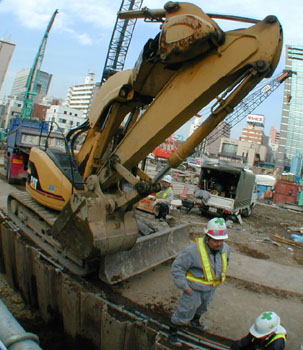 |
Better than a machine gun? |
Debts. What can I do?
I speared a plump one with a toothpick. Hostess tabs, alcohol, tobacco, alcohol. Debts.
I poked another, and in came my loan collector with his rather large associate. (I am sure that I have junior reporter Junko to thank for directing him to my office.)
"Listen chump," he said, pointing with his half-finished cigarette, "you miss another installment and I'll have to hand you over to my boy, here."
His brick-house-built henchman in pinstripes made a head-in-the-vice-like twisting motion with his large hands. I swallowed the second sardine.
"He has a special talent for making people find their wallets," my collector assured, and took two puffs.
I shrugged my shoulders - the international sign to show that funds are a problem.
"Knock off an atm - it's all the rage these days," he snapped. "I'm sure even a drunk like yourself can operate an excavator."
Together they then turned for the door. I raised a third out of the tin.
The crumbling of concrete, the bending of steel, the cracking of glass, the collapsing of plastic - all increasingly common sounds filtering through Japan's wee hours.
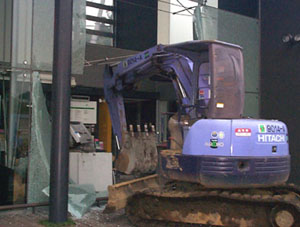 |
Photo courtesy of SFC Communication & Life Information Provider. |
After all, the destruction of an atm with an excavator is not exactly a sound of silence. And in these times of economic despair, the demolition of one and subsequent pillaging of its contents is getting to be the easiest way to get one's hands on some cash - and fast.
During Japan's rise to that of an economic giant following World War II, the excavator played a major role in distributing the nation's accumulated wealth to all of the archipelago's nooks and crannies through massive public works projects. Today, though, its powerful arm and sturdy bucket are no longer associated with such mundane blue-collar work; instead, it has developed stature, prestige, and respect in having eclipsed the machine gun as the preferred aid in bank robberies. Times, they indeed are changing.
The jobs are amazingly repetitive. In the dark of night, an excavator - or in Japanese parlance, a power shovel - is stolen and hauled by truck to the front of an atm machine, usually one installed in a bank lobby or standing free in a parking lot. There, a man with sufficient operating skills sets to demolishing it. (The manager of a junkyard raved to NHK's popular television program Close Up Gendai about the talents of one of his former employees - arrested last year for participating in an atm assault - in using heaving equipment.)
After completion, the excavator is abandoned at the site, sometimes with the engine still running, with the machine's cash box (or the entire machine itself) being taken to a remote area where the team of pirates set about extracting their treasure.
Police reports indicate that the destruction and theft usually takes a team of three men roughly five minutes. Witnesses are usually non-existent.
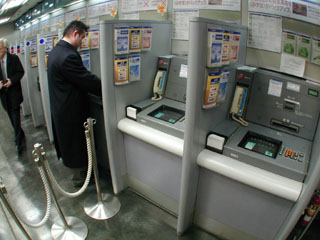 |
Ducks on the Pond? |
The raiders of these loaded atms are plundering with power shovels at a rate previously unmatched; the National Police Agency reports that last year thefts yielded 335 million yen over the course of 57 attempted robberies - a six-fold increase over the year before. This year such withdrawals are showing no signs of slowing with one caper in January in Saitama Prefecture netting 6 million yen.
Getting my share of this gravy is just what I set out to do. I'd begin by creating a step-by-step strategy based on exhaustive research and preparation.
Step 1: sizing up the enemy - the police.
Though arrests in these cases have been few, I knew I'd need to get an evaluation of the standard response procedure and protocol of law enforcement.
At the location of where Eitai Dori crosses the Sumida River, a police box sits on the corner. On one recent evening, its lone officer welcomed me inside. I first asked about preventative measures in the area.
"Since there are a lot of construction projects around here," he began, "we've been checking to make sure that keys to heavy equipment machines haven't been stolen."
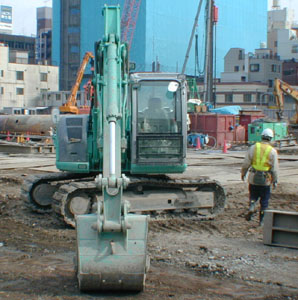 |
A construction site in Tokyo's Chuo Ward. |
(To get an idea of the excavator market, I had earlier contacted an auction house that specializes in dealing with used construction equipment. They boast a yard containing 150 machines in Kanagawa Prefecture - a hotbed for a lot of the recent atm attack activity. Since this was probably likely too far a distance to transport a machine for a Tokyo job, I thought of this as nothing more than mere window-shopping.)
"But I haven't seen anything," the officer assured, motioning with his right hand towards the traffic streaming up and down Eitai Dori, a street home to dozens of banks with atms vulnerably sitting within glass-enclosed lobbies. "Nothing at all."
I could see that I was making him nervous. I pressed further, "If you received a call claiming that a nearby atm was being destroyed down the street, what would you do?"
He shifted his feet a few times, pondering the answer. Then, after first putting his right hand in his jacket pocket and then removing it, he said, "I'd call police headquarters. They'd then dispatch squad cars to the scene."
Piece of cake. During the feet-shifting process alone, I could have the bucket plunged through the glass and the machine half destroyed. I scribbled down this information in my notebook and moved on.
Step 2: execution.
In the offices of one of Japan's big-five construction companies near Shinjuku Station, I consulted an expert in excavation. To be blunt, excavation is his business, and he didn't bat an eye in offering assistance.
"The police are reporting that these jobs are taking 5 minutes," I said. "Is this possible?"
"Setup time alone will be three to four minutes," he estimated, putting down a few notes with a pencil on scratch paper. "Then the actual destruction itself will be ten minutes - at a minimum. The 5-minute figure is likely just a way of covering up for a lousy response time on their part."
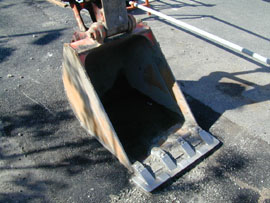 |
Just the right size. |
I thought about the shifty feet of the officer and I looked down at my notebook where "equipment selection" was highlighted.
"And the size of the excavator?"
He pulled some brochures out from a three-ring binder sitting on his bookshelf. They were from construction equipment manufacturer Komatsu.
"For these jobs, you'll need one with a bucket capacity of no more than 0.1 cubic meters," he surmised.
Each brochure was filled with diagrams and charts giving a rundown of all the sizes, shapes, capacities, and options on offer.
"Anything more and you'll have a tough time in transporting it; mobility is necessary for this sort of work," he continued. "But you know, if you can somehow get one to the site with a capacity of around 0.7 cubic meters, you could knock the sucker off the wall in one fell swoop. Aim at the center of the span supporting it - that'll be the weak spot, structurally speaking."
He paused.
"But this is only if the atm is attached to the steel frame of the building. If it's encased in concrete, you're going to have to get a hammer attachment."
I made a mental note about the necessity of reconnaissance.
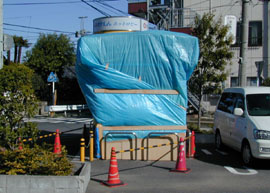 |
What's left of an ATM in the Maruetsu supermarket parking lot in Kawasaki. |
"But what about the free-standing numbers in parking lots or bank lobbies? Those are more common, right?"
"Oh, well, those are sitting ducks," he lectured. "You don't need my help for those..."
I shrugged my shoulders in embarrassment.
"What about the noise then?" I asked. "This has to make a lot of racket. Why hardly any witnesses?"
"Think about it - if you came out of Shinjuku Station one night and saw someone destroying a Mizuho atm you'd assume it to be a construction project, right?"
At that moment, I knew Bonnie and Clyde were kicking themselves in their graves.
"How about the truck?"
"A four-ton capacity truck will do. But it has to have a drop-down ladder ramp to load and unload the excavator - a point often overlooked."
After thanking him and beginning for the door, I recalled the wise words of famous bank robber Willie Sutton. "You can't rob a bank on charm and personality," he once said. And as my study in atm destruction showed, there are indeed better ways. I was all set.
Note: While this report includes some editorial liberties to allow for easier reading, the contents, as far as strategy, are absolutely genuine.

